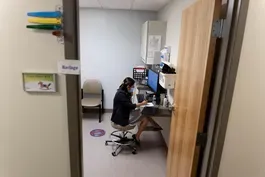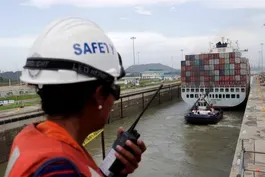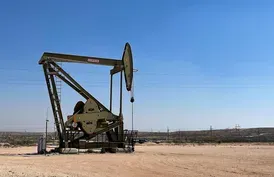
Engineers turn to beavers for insights into managing water
Clip: 2/6/2025 | 7m 39sVideo has Closed Captions
Why engineers are turning to beavers for insights into managing water resources
Beavers and the dams they build are not always embraced in the areas where they do their work. But there's a growing recognition that they also are building a kind of natural infrastructure that helps with water management and the climate. Science correspondent Miles O'Brien went to see the beavers at work during their busy season and has the story for our ongoing coverage of Tipping Points.
Major corporate funding for the PBS News Hour is provided by BDO, BNSF, Consumer Cellular, American Cruise Lines, and Raymond James. Funding for the PBS NewsHour Weekend is provided by...

Engineers turn to beavers for insights into managing water
Clip: 2/6/2025 | 7m 39sVideo has Closed Captions
Beavers and the dams they build are not always embraced in the areas where they do their work. But there's a growing recognition that they also are building a kind of natural infrastructure that helps with water management and the climate. Science correspondent Miles O'Brien went to see the beavers at work during their busy season and has the story for our ongoing coverage of Tipping Points.
How to Watch PBS News Hour
PBS News Hour is available to stream on pbs.org and the free PBS App, available on iPhone, Apple TV, Android TV, Android smartphones, Amazon Fire TV, Amazon Fire Tablet, Roku, Samsung Smart TV, and Vizio.
Providing Support for PBS.org
Learn Moreabout PBS online sponsorshipGEOFF BENNETT: And now a very different kind of story about the environment.
Beavers and the dams they build are not always embraced in certain areas.
They can create problems, with flooding, crops and other damage.
But there's a growing recognition that they're also building a kind of natural infrastructure that helps with water management, wildfire mitigation and the climate.
Science correspondent Miles O'Brien went to see the beavers at work during their busy season and has the story for our ongoing coverage of the environment called Tipping Points.
MILES O'BRIEN: This team of scientists is gearing up to get waist deep on a quest to better understand nature's hardworking engineers and climate warriors, beavers.
They invited me along.
And I was, well, eager to join them.
Going deep.
Going deep into the world of beavers here.
Leading this happy band of beaver believers is Emily Fairfax.
She's an ecohydrologist and assistant professor of geography at the University of Minnesota.
We met in Southern Wyoming.
EMILY FAIRFAX, University of Minnesota Twin Cities: We're about to go into the beaver wetlands now.
MILES O'BRIEN: We're in the Medicine Bow National Forest, and we're going into a beaver complex, which is like a huge beaver neighborhood, maintained by one beaver family.
Before we began our trek, we got an advanced peak, thanks to Emily's prowess as a drone pilot.
EMILY FAIRFAX: So, right now, I'm flying over the corridor that the beavers have dammed.
And we're seeing quite a few beaver ponds.
MILES O'BRIEN: In 2020, a big wildfire ripped through here.
There is still plenty of evidence of that.
Dead gray trees starkly define the edges of a lush, linear oasis.
How long does this green swathe go?
EMILY FAIRFAX: So, right now, I have flown a half-a-kilometer away along this path, and it's all beaver-engineered.
We think this is just one family doing this work here.
Well, they take little pieces.
MILES O'BRIEN: One family?
EMILY FAIRFAX: One family.
MILES O'BRIEN: And for more than a kilometer?
EMILY FAIRFAX: Mm-hmm.
MILES O'BRIEN: We didn't see them, but they sure are busy.
The parents mate for life.
They have a litter once a year, anywhere between one and six kits.
EMILY FAIRFAX: So in a given family at a given time, you could expect there to be somewhere between six and 10 beavers, with the parents, the -- quote, unquote -- "teenage beavers," and then the little kits.
MILES O'BRIEN: Beavers build dams for protection.
The water cover they create is an effective defense against predators for a semiaquatic rodent.
This is all about just having a protected area to move around.
That's all it is.
EMILY FAIRFAX: Yes.
This is all about safety, protected area.
We're in one pond right now, but if you look at this place from above, you will see there's probably 14, 15 beaver dams in a row.
They can go all the way up and down this river corridor and stay in the water 95 percent of the time, access more food, access more building material, and generally have a bigger area to roam.
MILES O'BRIEN: Emily and I were knee deep in a pond that has captured her scientific interest.
She and her team got to work.
EMILY FAIRFAX: So what's our temp here?
WOMAN: Seven-point-seven.
EMILY FAIRFAX: Depth of the sponge?
WOMAN: Ninety-four centimeters.
Ninety-four centimeters.
EMILY FAIRFAX: And then our flow rate?
WOMAN: Zero-point-zero.
MILES O'BRIEN: All the measuring of the sediment, all the things you're doing here, give us a sense of what you're after.
EMILY FAIRFAX: This is a post-fire site, so there has been a lot of burning here around the beaver wetlands.
The wetland is intact.
One of the things we want to know is, how much sediment is this pond catching?
MILES O'BRIEN: The team often gets below the surface, at this pond in Colorado snorkeling to see beaver engineering and the sediment it traps.
This dampens the causes and effects of wildfires.
EMILY FAIRFAX: The most visually dramatic is clearly the refugia or this fireproof patch.
We have mature pine trees here.
We have mature willows.
We have beavers.
We have the sediment capture.
We have all sorts of different things that are continuing to provide benefits.
MILES O'BRIEN: The streams that flow through here are the headwaters of the Colorado, one of the most overutilized rivers in the world.
The natural infrastructure beavers build can really help the river.
EMILY FAIRFAX: So every one of these wetlands is like a speed bump for the water, delaying that water.
And especially as we see climate change and things get warmer and we have more rain and less snow, it's really important to keep the water up in the headwaters longer.
MILES O'BRIEN: Scientists estimate there were between 100 and 400 million beavers in North America before European migration.
For a few centuries, beavers were trapped for their pelts and killed as nuisances to near extinction.
Beavers can cause unwelcome flooding on property and crops.
Videos showing their dams and lodges being gleefully blown to smithereens are all over social media.
But land managers are now more likely to see them as an ally, and they're taking some unusual steps to try to bring back more beavers.
Scott Miller is the aquatic resources program lead for the Federal Bureau of Land Management.
He's at the center of a campaign to restore streams and rivers and the lush vegetation that borders them, so-called riparian zones.
To do that he's thinking like a beaver, building beaver dam analogs.
SCOTT MILLER, Bureau of Land Management: This is just a hand-built structure trying to mimic what beaver naturally do.
We first drive the post into the ground, we put some sod in, and then we're weaving willow and aspen branches between the poles, and then we're putting some more sod in.
They can be built in anywhere from a half-hour to two hours, depending on the size and complexity.
MILES O'BRIEN: They're building a hundred of them here at the Muddy Creek watershed near Rawlins, Wyoming.
Lot, Of little structures, instead of a few big overbuilt ones.
SCOTT MILLER: This system is starting to naturally recover.
Maybe it would traditionally take a decade, and we're trying to get that same amount of improvement in three to five years by coming in here and doing this work.
MILES O'BRIEN: Cattle rancher Tom Chant and his father before him have been working this patch of land along Muddy Creek for more than 20 years.
When they first got here, it was trampled by overgrazing sheep.
If we were standing here 22 years ago on this day, what would it look like here?
TOM CHANT, Cattle Rancher: I remember coming down here, and this would be a dust cloud when the cattle come right down this creek.
It was -- there was no vegetation.
MILES O'BRIEN: The BLM improved roads, built fences to allow for rotational grazing, encouraged the growth of willow trees and built the beaver dam analogs.
So do your fellow ranchers, are they skeptical of this?
TOM CHANT: Any of them that potentially are on the fence, they must not like grass, right?
Like, we're shading the creek, cooling the water temperature.
Cows are happier when they got a cold drink of water at 90 degrees, right?
MILES O'BRIEN: Tom Chant has two sons, rodeo stars in the making.
He hopes they will one day succeed him in running the ranch.
He thinks nature's engineers will make the succession a little easier.
For the "PBS News Hour," I'm Miles O'Brien, near Rawlins, Wyoming.
Deadline for federal workers to resign delayed by judge
Video has Closed Captions
Deadline for federal workers to resign delayed as Democrats step up fight against Musk (3m 32s)
Democracy advocate examines Trump changes to government
Video has Closed Captions
Democracy advocate examines how Trump is changing the U.S. government (7m 22s)
Funding freeze impacts community health, Head Start programs
Video has Closed Captions
How the federal funding freeze is impacting community health and Head Start programs (6m 35s)
GOP Sen. Schmitt says 'FBI ripe for real reform'
Video has Closed Captions
GOP Sen. Schmitt says 'FBI ripe for real reform' and Patel has the experience to do it (7m 8s)
News Wrap: Panama's president rejects U.S. canal fee claim
Video has Closed Captions
News Wrap: Panama's president rejects U.S. claim of canal transit fee deal (4m 38s)
'Poet of Havana' uses music to address pain of politics
Video has Closed Captions
'Poet of Havana' uses his music to address pain caused by politics (9m 1s)
Trump working to dismantle efforts to fight climate change
Video has Closed Captions
Trump aggressively working to dismantle U.S. efforts to fight climate change (5m 53s)
Providing Support for PBS.org
Learn Moreabout PBS online sponsorshipMajor corporate funding for the PBS News Hour is provided by BDO, BNSF, Consumer Cellular, American Cruise Lines, and Raymond James. Funding for the PBS NewsHour Weekend is provided by...



















